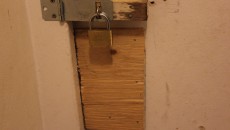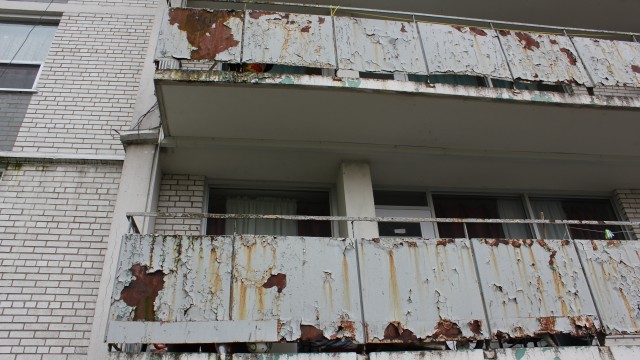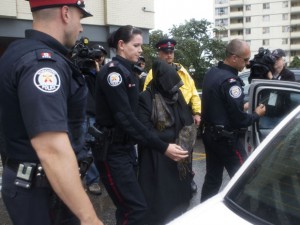“I’ve been living here for three years, and last night was the first time I’ve seen anyone come to fix the laundry room,” says a 33-year old resident of 3400 Eglinton Avenue East.
The laundry room in the basement of the Markham and Eglinton area building is full of washing machines and dryers, but several residents have complained about them never working properly, gobbling up people’s cash for no return. On hot summer days and especially in cold winter months, when the snow piles up outside the building and on the sidewalks, they have to carry their laundry nearly half a kilometre to a laundromat.
But the night before Monday October 19, someone finally came to take a look at the machines in the laundry room. That might have been because on Monday morning, the 16-storey building in Scarborough Village was being audited by officers of Municipal Licensing and Standards from the City of Toronto.
The building is in bad condition, both inside and outside. Residents frequently complain about an unresponsive management. Repairs and maintenance are rarely done in a timely manner. One couple became so tired of asking for repairs that they repainted and retiled the apartment themselves—“Not because we wanted to but because we had to. We did it to protect our family—we have two kids.”
Another resident had a broken lock on his door, finally replacing it with a padlock he installed himself after waiting months for the building management to make the repair.
The most common complaint of all residents is the dirty carpet in all of the hallways, which is stained throughout and often smells. “When visitors come, they smell it and think it is coming from our homes,” one resident said. The carpet had not been changed, according to some residents, for over ten years.
After the municipal inspectors ruled that the carpets are not kept in a “clean and sanitary condition” management is in discussion about replacing the carpet. They began to experiment with replacing the carpet on the second floor—where the building superintendent lives, and have now removed the carpet on all of the floors of the building.
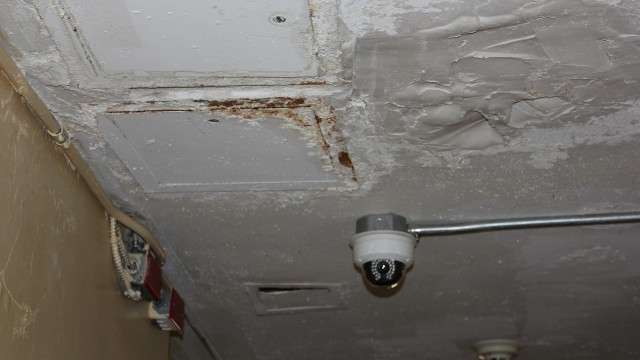
A surveillance camera monitoring tenants movements in the building, surrounded by hastily repaired ceiling damaged by water leakage.
Leaks are very common in the building. On October 10, the ceiling of the 17th floor hallway was dripping water that we caught on video. When the superintendent was told about the leak, she simply denied it.On the 17th floor, residents say that leaks have led to mould growing in the carpet and floor.
On October 19, one resident showed BASICS her bathroom ceiling, which was caving in due to leaks from the unit above her. A few days later chunks of the ceiling and water actually fell on her, leaving a gaping hole in the ceiling. On November 6, a plumber finally came to “fix” the ceiling—but just seems to have papered over it poorly, with nothing done to actually fix the source of the leak. The area is damp to the touch with bubbles coming out of it. “I can still hear the water dripping,” the resident said. She continues to remain concerned about mould and mildew in the bathroom, a safety concern for her three-year old daughter.

The ceiling of this washroom collapsed on a tenant due to an unresolved issue with water damage from the unit above.
BASICS spoke to municipal officers who said that the state of disrepair in the building was not surprising. Dozens of apartment buildings throughout the city are in horrible condition because the owners simply treat them as a business from which they want to turn a profit.
Despite the municipal officer’s attempts, there was not much they could do about repairs inside units unless they directly received complaints from tenants. But there are many problems, and bringing up units to minimum standards did not mean that they were good standards. The minimum standards require the building to stick to the old code, and not the new one.
For example, the bathrooms in 3400 Eglinton Avenue East all have a passive ventilation system, good enough for the 1950s, but no longer standard—bathrooms now require fans to actively pump the damp air out. The old system not only does a poor job of pushing damp air out, it can even bring damp air in from outside and from other units. This leads to growing problems with mould and mildew.
The best and maybe only way that residents can bring about a change, according to the municipal officer we spoke to, is to build community among themselves. That means keeping an eye out for each other and for the building, and holding unresponsive building owners to account through collective action. Limiting actions to filing individual complaints will not push the management to respond. Only through collective action can we actually put pressure on the management and building owner to make the changes that are necessary for the building.
]]>
In 2014, the Toronto Community Housing Corporation issued its annual Performance Report, a document which measures whether TCHC reached its own targets in providing repairs and “sustainable living” conditions for tenants. Last year’s report included a section for Resident Satisfaction.
This new section meant to examine whether there was an “increase in resident satisfaction with the quality and conditions of their homes and buildings”, but concluded that there was “no tool to measure progress” and that a “resident survey [is] required.”
In the 2015 TCH Performance Report, however, the same statement is written under Resident Satisfaction: “Measure under development”.
Since TCHC seems pretty busy with coming up with a survey, BASICS has decided to report some of the experiences which residents at 3171 Eglinton Ave E. have shared about the state of repairs in their aging complex.
*Fatima, a resident of 3171 Eglinton for four years, described her first few months moving into the apartment: “When I arrived, I needed to repaint the walls to accommodate my son’s respiratory issues—because it wasn’t the ‘normal’ paint, I was charged for 50% of the cost.”
Respiratory concerns are shared by many residents due to the mold that is growing throughout TCHC building. Management is slow to make any changes in the perpetually damaged state of the building: ”When things go wrong, we must make an appointment with the superintendent. When you make an appointment, people only show up after three weeks, sometimes a month,” said Bilal, another resident.
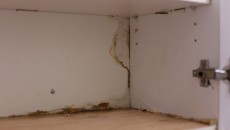
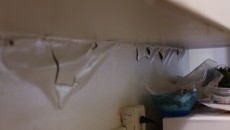
Fatima and Bilal’s experiences are shared widely by others. Jacob, a long-term resident, explained that he reported mold in his kitchen cabinets repeatedly: “When they finally came to address it, they just painted over it. I keep my cups in there, it’s a health concern”.
Some aspects of the TCHC building seem to never get fixed, as BASICS reporters realized during our weekly stairwell hikes to the twelfth floor. “When I came, it was because I was told the building was very accessible. Then the elevators started to break down. Now they break two or three times a month,” said Fatima. “They are still broken now.”
Just this month, BASICS reporters saw one woman get her foot stuck in the doors of the elevator at 3171 Eglinton, due to its faltering ability to sense the presence of passing bodies. Disturbingly, after the initial shock, she seemed fairly dismissive of the occurrence: “It’s not the first time,” she said with a shrug.
The dismissal of individual experiences are unsurprising when seeing how building-wide infrastructural crises are dealt with. Bilal described the bursting of hot water from broken pipes in February: “The water flooded the plaster in the entrance, it wasn’t fixed until March.”
The fall of four storeys worth of brick in April of this year was covered by multiple Toronto news sources. Residents who spoke to us described it as “terrifying.” Hannah, a mother who has lived at 3171 for decades, reported being “afraid to sleep in my own room at night.”
Residents of that end of the complex were given a complimentary hotel-stay three weeks after the event, perhaps as a belated apology by TCHC for the potentially-life threatening situation. Today, the outskirts of the building are surrounded by two fences, apparently in the hope that no remaining bricks will fall on passing pedestrians. One fence is a metal grille, and the other plywood. Yet the ravaged south end of the building remains covered by no more than a long sheet of tarpaulin.
Experienced tenants have told BASICS repeatedly that after private property management companies—such as DMS, which currently runs 3171 Eglinton—took over from TCHC employees, repairs have become even rarer and less effective.
The TCHC website claims that “contract management is a cost-effective way to provide the same high level of service to tenants.” If the above tenant experiences are what TCHC identifies as a high level of service, then it is clearly unqualified to provide any assessment of “sustainable living” or “resident satisfaction”. Only the tenants themselves are qualified to measure the performance of TCHC, and this can only be achieved through by communicating and organising with one another.
*Some of the names of 3171 Eglinton residents have been changed in this article at their request.
]]>
“Two people have been killed since I moved in here. Of course I feel unsafe. I feel more safe in the street than in my home.”
This is how Maryam*, a woman in her early twenties and a three-year resident of 3171 Eglinton Avenue—one of the TCHC high-rises at the intersection with Markham Road—describes her life in the building.
“I don’t feel comfortable inviting friends over. Once a friend spent the night, and at two a.m. someone started banging on the door demanding to come in. How are two women alone in an apartment at that hour going to feel?”
Of the dozens of residents at 3171 with whom BASICS has spoken, nearly all have similar concerns about safety. For female residents in particular, the greatest feeling of threat can sometimes come from other residents—in particular, men. Such feelings are common for women who, like Maryam, live alone or as single mothers.
Due to the seeming lack of other choices, some residents turn to the police. For example, after racist curses were scratched onto her door a few months ago, Maryam immediately informed the Toronto Police Service. When constables came by, however, she found them unwilling to pay even cursory attention to the situation: “When I told them about these words someone had written and asked them what they were going to do, one of them just shrugged and said, ‘It’s TCHC’.”
The cop’s indifference to Maryam’s concerns reflects the attitude of the police department towards the concerns of low-income residents. After the murder of 22 year-old Dillon Phillips in the stairwell on September 2014, a second resident recalls the police and TCHC management as encouraging residents to “Take back your building”. In such circumstances, residents and onlookers are forced to ask whether the police are in place to protect or divide communities.
Trapped between a rock (insecurity) and a hard place (disdain and disinterest from the police), Maryam’s only goal is to get as far from community housing as possible. “I don’t hang out in the area, I don’t want to be here. When I’m gone, I’ll never think about this place again,” she said to BASICS.
For a woman in her position, this view is entirely reasonable, and it is one which many women in the building seem to share. Yet when residents are lucky enough to get a transfer or start making enough money to move out, their apartments will immediately be filled by a few more people from TCHC’s 160,000-household waiting list. New residents, as well as the many who are unable to leave, are simply forced into the same stressful, unchanging, and sometimes dangerous circumstances. Unable and uninterested in providing a secure home, TCHC and the Toronto Police Service bring TCHC residents to see their apartments as places where fear and suspicion are constant.
When asked if her concerns about security cause alienation from other residents, Maryam said, “Definitely.” In a building where turnover is high, security is low, and many wish to leave, it is difficult for residents to build a sense of trust in the community.
Yet the police prove, as they did in Maryam’s case, that they have little interest in protecting working-class and racialized women—and this is without any discussion of police treatment of working-class and racialized men.
Under these circumstances, who better for female residents to turn toward than one another? Protective links already exist in small, informal ways—between friends, for instance. But if these links could turn into something larger and more organised, a safer and more inclusive community for women—and perhaps also men—at 3171 Eglinton could take shape.
*At her request, we have given Maryam a pseudonym for this article.
(Photo Credit: Chris Doucette, Toronto Sun)
]]>]]>
On Jan 3, 2014, the Kitchener-Waterloo Spot Collective announced the relaunching and professionalising of their people’s programs.
The people’s programs, which include the serving of free food, programs for those dealing with addiction, and literacy programs, have come out of the need to deal with the problems the community faces by mobilising the community, says organizer Amber Sinson.
“Our children need food, warm winter clothing and basic needs that are not provided by the state,” Amber continues. “It’s obvious that we must rely on ourselves to solve our own problems.”
The Spot Collective, created in 1998 by street youth and socialist students looking for for solutions to the problems they were facing, has always focused on balancing the immediate needs of the community with solving the root causes of poverty by attacking systemic problems, according to Sinson. The relaunching of the people’s programs is a continuation of this combined approach.
When asked about food banks and other social agencies that provide such services she replied, “They humiliate you and make you feel like garbage, and that it’s your fault you’re poor. They also do nothing to address the issues behind poverty.”
Wesley Gibbons, a person who uses the peoples programs, also added, “You can only get one or two boxes a month from the food bank and most of the stuff is expired.”
Those interested in participating are invited to come out to meetings Wednesday nights at 6pm at 43 Queen St., after the free food servings. Contact: 226-289-2559.
]]>By: Kabir Joshi-Vijayan
Rob Ford might be the most (in)famous politician in Canadian history. Every other week a new intoxicated blunder is revealed while the entire local political establishment tries to force his resignation.
Despite the hundreds of hours of sensational reporting, the story is actually unimpressive: a ‘public’ official abusing drugs and alcohol, threatening personal rivals and flaunting his racist and homophobic views is pretty normal.
The tale of a crack smoking Mayor pales in comparison with another municipal controversy, a scandal which has faded from headlines since Rob’s escapades began to dominate.
This involves a force that has committed the most blatant violations of human rights, one that has paid over $27 million in civil lawsuits since 2000 and is now facing two new litigations totalling $65.4 million. This is a force the entire city watched taze the lifeless body of a frightened 18-year old after they shot him nine times – the latest in dozens of killings of largely Black, Brown or mentally-ill victims.
The force being described is of course the Toronto Police Service.
The incident that should have drawn the most outrage in relation to the Ford scandal was the heavily armed attack on the neighbourhood of Dixon and Kipling in June 2013. Over 100 officers with bullet proof vests, flash grenades, battering rams and automatic weapons stormed into three buildings at 5am to arrest 19 men and women.
Doors were broken down, apartments were torn apart and mothers, grandmothers and youth were terrorized and assaulted, including a 67-year-old woman kicked in the face, told by officers to die, and forced to watch as police tried to handcuff her 96-year old mother who had fallen violently out of bed.
This paramilitary operation was called ‘Project Traveller’ and it was targeted primarily against the Somali community. The raid was praised and lauded as having cleaned the neighbourhood of supposed gang members. Police announced to several residents they were there because of Rob Ford, and the Police Chief later revealed that a videotape of the Mayor had been found during the operation.
This is only the latest in dozens of similar operations conducted by Toronto Police, every one of them directed at working-class, racialized communities and arresting primarily young Black men and women. In most cases it is later revealed that well over half of those arrested are completely innocent, (as in ‘Project Flicker’ in Ardwick in 2005, or ‘Project Kryptic’ in Driftwood in 2007). These raids have proven to do nothing to end violence, and in the case of Driftwood, police were back four years later (Dec 2011) to lock up a new generation of youth.
These projects allow police to pose for photo ops in front of seized weapons, drugs and money and attempt to prove to city residents that their $1 billion annual budget isn’t going to waste.
Cops grab any cash they find in raided units without any proof of their illegal origin. Communities which face high levels of poverty, such as Somalis, Jamaicans and South Asians, often keep quantities of money at home. Thousands of dollars are taken – by the police. In ‘Project Traveller’ over $575,000 was looted.
The Rob Ford scandal is also a perfect example of the hypocrisy associated with policing in this city. Although police used incriminating evidence to humiliate Ford and try and force his resignation, they made not one move to charge him.
In Dixon meanwhile, the basis for violently rounding up many of the accused, some of whom are still languishing in jails, was nothing more than them having supposed criminals as relatives, friends or contacts in their phones: this includes senior-aged parents arrested and charged for not knowing that their children were allegedly keeping illegal items in the house.
The Mayor brazenly bought and used packages of drugs in public parking lots and washrooms, spoke for hours on the phone about his criminal activities, and yet police claim they did not have the grounds to arrest, search or even make him answer questions.
In working-class communities like Dixon, even outside of raids, youth are stopped and searched for simply being outside too late or being in too large a group. They are arrested and assaulted for having small amounts of marijuana or for trespassing violations.
From a larger perspective, the same Canadian state that is now spending $12 billion over the next 4 years to build new prisons (such as the new $540 million South Toronto Detention Center), to lock up people at the lowest levels of the drug trade, is the same country where local politicians are charged with actively collaborating with the mob. It is the same country that props up narco states like Colombia through ‘free-trade’ deals and cozy diplomatic relations; the same country that helped build Afghanistan into the largest producer of opium and heroin in the world.
The fact is the Toronto Police are not a group unto themselves. The physical attacks such as the raids, brutality and daily harassment, go hand-in-hand with social and economic attacks on these same communities from other branches of the system. In Dixon economic warfare means imposed conditions of chronic unemployment, low paying jobs and criminalizing industries such as Khat (a mild stimulant plant leaf no more harmful than coffee or shisha, but widely used among East Africans).
The sitcom/crime drama which City Hall has become over the past year has left us misinformed and distracted from the real issues at hand. Many working people have developed a liking for the slow-witted millionaire in the Mayor’s office, thinking the political establishment’s opposition to him is proof that he is somehow on our side. Bill Blair has been able to look like the poised and honest chief after the public outrage following the G20 and the killing of Sammy Yatim.
It is clear that neither side in this conflict are on our side! We as oppressed and working people shouldn’t have to rely on the Fords of the world bribing us to get us funding and social programs. We must also recognize that violations like the June 13 attack on Dixon are only able to happen because we are disorganized and divided.
It is time to build real mass movements in our neighbourhoods and communities to solve our own problems, raise and educate our children and oppose state violence. Police raids, carding, harassment, violence and mass incarceration will not end by suing, begging or reforming that structure but will only be the result of a strong, united and organized community prepared to defend itself.
]]>More than 30,000 people live in these two square kilometers. A considerable proportion of them are South Asian immigrants, a considerable proportion of them are from Pakistan. Many are unemployed, underemployed, and poor. They are overeducated, overqualified, but insufficiently endowed with “Canadian experience.”
They work multiple jobs, but cannot afford adequate housing, so must share overpriced apartments with others in the same bind. Their landlords, parasitic by nature, invent ever more extortionist fees to increase profits, while their drive to reduce costs threatens the health and safety of tenants.
The children, who make up a third of the community, leave overcrowded homes to go to overcrowded, under-resourced schools, where they are denied the quality public education available to communities of rich, white, “Canadian” children not ten minutes away. They are culturally ghettoized and treated as the “other”.
But they have not been silent.
In June 2011, some of Thorncliffe’s youngest tenants were at the forefront of a rally for housing justice organized by the Thorncliffe Park Tenants’ Association (TPTA). The TPTA, which consists of a group of volunteers representing three of the worst-managed buildings in the area, has served as a critical organizing force in the community, channeling the communities’ anger and frustration into collective action. Overdue maintenance issues, exorbitant “transfer” fees, pest infestations and extra charges for air conditioners were just some of the concerns that led tenants to demonstrate.
After almost two years and no improvements in housing conditions, members of the TPTA again mobilized residents this summer and on June 8 held a rally to send their landlords a strong message. Children from the TPTA’s tutoring program designed posters that set the tone, with slogans such as, “If you don’t give us our AC’s, We’ll make you sweat,” and “Your smart-meter can’t outsmart us,” referring to the illegal monitoring of electricity use per unit to charge tenants extra for hydro.
The vocal young chanters led the adults in the march around the community. With protesters of every age, here was the past, present and future of a community that recognizes exploitation and aspires to end it. There were those, too, who watched from their balconies, afraid to participate in the protest lest they jeopardize their already precarious housing situation. Several marchers also came from outside the community to show their support.

Pat Moore, a long-time housing activist in the area, holds up an image of her from 1994 when their organizing successfully turned one of the local buildings into a co-op. Photo Credit: BASICS Community News Service
Some of the adults present at the rally have been involved in the housing struggle since the 1970s. One such long-time activist, Pat Moore, delivered an inspirational history lesson to the marchers, sharing the story of how she and a group of tenants—pictured in a photo from 1994 that she held up—successfully converted one local building into a co-op which is now run by tenants. But the fight is not over, the victory is not complete. With the recent trend towards privatization, this building too is at risk of being turned over to the private sector, thus erasing a testament to tenant power in the community.
Finding power in their own languages and challenging the monopoly of the English language, protesters were vocal in airing their grievances, frequently grabbing hold of the loudspeaker from the organizers as the march progressed. By commanding the attention of their fellow marchers, neighbours and landlords, the strong voices of some women in hijabs—like the one pictured here—defied certain gender norms and characterizations of hijabi women offered by racist mainstream narratives.
One uninvited guest at the rally was Councillor John Parker—hailing from the neighbouring rich, largely white community, Leaside Park—who quickly made evident which side of the fight he was on. Following his pattern of patronizing interactions with this racialized, low-income community, he reinforced racist stereotypes of immigrants being filthy and irresponsible.
In a press release from the TPTA, the organization declared that it would not “stand for this kind of racism.” “As far as we are concerned,” said Shakeel Ahmed, a long-time Thorncliffe resident, “we don’t have a City Councillor. Every time he shows up here, he leaves more of a mess than he cleans up.”
]]>